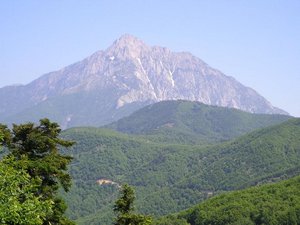Mount Athos
Mount Athos is a mountain and a peninsula in Macedonia, northern Greece, called Άγιο Όρος (Ayio Oros or "Holy Mountain") in Modern Greek, or Ἅγιον Ὄρος (Hagion Oros) in Classical Greek. It is home to 20 Orthodox monasteries and forms an autonomous state under Greek sovereignty. Only monks are allowed to live on Athos and the current population numbers around 1,400. The peninsula, the easternmost "leg" of the larger Chalkidiki peninsula, protrudes into the Aegean Sea for some 60 km at a width between 7 to 12 km and covers an area of about 390 km², with the actual mountain and its steep, densely forested slopes reaching up to 2,033 m.
The seas around the end of the peninsula can be dangerous. Xerxes I had a channel excavated across the isthmus to allow the passage of his invasion fleet in 483 BC.
History
Mount Athos as a monastic community was formally founded in 963, when St. Athanasius (not to be confused with the 4th century St. Athanasius the Great) established the monastery of Great Lavra, still the largest and most prominent of the 20 monasteries. It enjoyed the protection of the emperors of the Eastern Roman Empire during the following centuries and its wealth and possessions grew considerably. The Fourth Crusade in the 13th century brought new Roman Catholic overlords which forced the monks to seek protection from Pope Innocent III, until the restoration of the Byzantine Empire. It was raided by Catalan mercenaries in the 14th century, a century that also saw the theological conflict over the hesychasm practised on Mount Athos and defended by Gregory Palamas.
The Byzantine Empire collapsed in the 15th century and the newly established Islamic Ottoman Empire took over. They heavily taxed the monasteries, but for the most part left them alone. The population of monks and their wealth declined over the next centuries, but was revitalised around the 19th century by the donations and new arrivals from other Orthodox countries, such as Russia, Bulgaria, Romania and Serbia, while each country came to exert its influence on individual monasteries. In 1912, during the First Balkan War, the Ottomans were forced out and after a brief conflict between Greece and Russia over sovereignty, the peninsula formally came under Greek sovereignty after World War I.
Politically the peninsula is mostly self-governed and consists of 20 main monasteries and the capital city and administrative centre, Karyes, also home to a governor as the representative of the Greek state. Beyond the monasteries there are 12 sketae, smaller communities of monks, as well as many (solitary) hermitages throughout the peninsula. Visits to the peninsula are possible for laymen, but they need special permission.
Women are completely barred from the peninsula, a fact which has earned a certain amount of fame; even female domestic animals (with the exception, some say, of cats, as well as chickens which lay eggs that provide the fresh egg yolk needed for the paint used in iconography) are forbidden. However, during the Greek Civil War, Athos did shelter refugees including women and girls. [1]
In modern times, the Mount Athos monasteries have repeatedly been struck by wildfires, e.g. in August 1990, and in March 2004, fire gutted a large section of the Serbian monastary, Chilandari. Due to the secluded locations of the monasteries, often atop small hills, as well as the unavailability of suitable fire fighting gear, the damages inflicted by these fires are often considerable.
Languages
Greek is commonly used in all Greek monasteries, but in some monasteries there are other languages in use, in St. Panteleimon, Russian; in Chilandari Serbo-Croat; in Zographou, Bulgarian; and in the sketae of Prodromos and Lacu, Romanian. Today, many of the Greek monks are better educated and can speak English.
List of Monasteries

The monasteries, in hierarchical order:
- Great Lavra (Megisti Lavra)
- Vatopedi Monastery
- Iviron Monastery
- Chilandari Monastery (Hilandar)
- Dionysiou Monastery
- Koutloumousiou Monastery
- Pantokratoros Monastery
- Xeropotamou Monastery
- Zographou Monastery
- Dochiariou Monastery
- Karakalou Monastery
- Philotheou Monastery
- Simonopetra Monastery
- St. Paul's Monastery
- Stavronikita Monastery
- Xenophontos Monastery
- Grigoriou Monastery
- Esphigmenou Monastery
- St. Panteleimon's Monastery
- Konstamonitou Monastery
The sketes:
- Prodromou Skete
- St. Anne's Skete
- Kafsokalyvia Skete
- Skete of Vatopedi
- Skete of Iviron
- Skete of Koutloumousiou
- Skete of Pantokratoros
- New Skete (Nea Skiti)
- Lacu Skete (Lakkoskete)
- Skete of Xenophontos
- St. Basil's Skete
- Provata Skete
External links
Categories > Images
Categories > OrthodoxWiki > Featured Articles
Categories > Places
Categories > Places > Monasteries
Categories > Places > Monasteries > Athonite Monasteries
Categories > Places > Orthodox UNESCO World Heritage Sites
Categories > Places > Pilgrimage Sites
Categories > Spirituality > Asceticism
Categories > Spirituality > Asceticism
